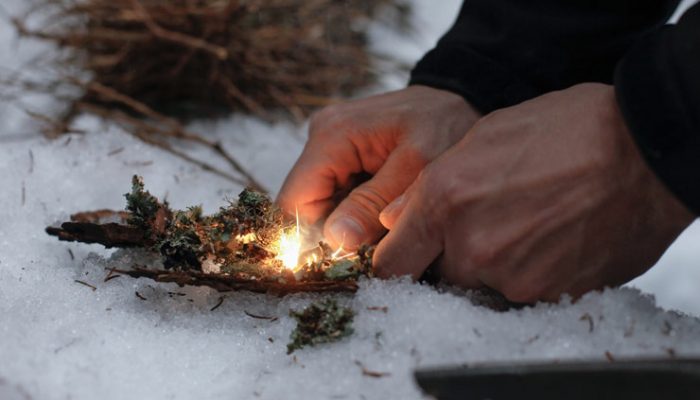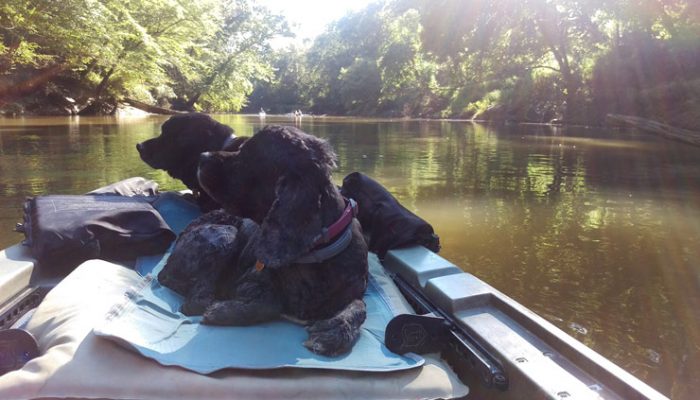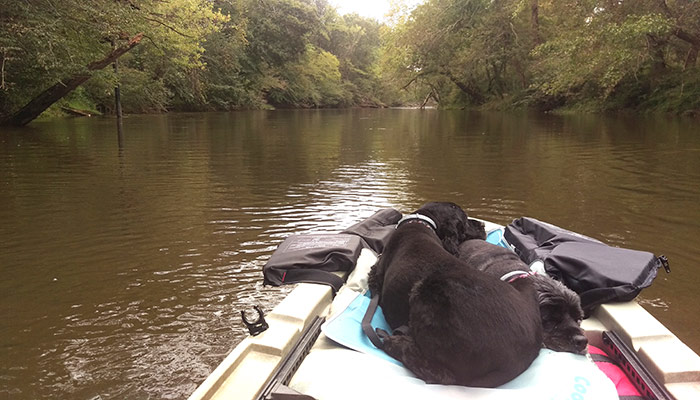I have some favorite products for our outdoor activities to share with you. In trying…

People get lost. It happens.
Getting lost in the woods or any remote place that is unfamiliar can result in some pretty bad stuff. Being prepared for a trip into the wild is super important. Below I have compiled some information that I have gathered over the years from experience and from others. Take a look and please offer additional tips in the comments. I love hearing about new tricks for survival.
Leave your ego at home.
A lot of bad incidents occur because some jagoff thought they were too cool for school. Maybe they decided to forego telling someone they were going out alone. Perhaps they brought a single lighter instead of bringing more and they don’t know how to start a fire with what nature provides. Maybe they headed out in just a T-shirt to impress the other guys.
The only competition is between you and your ability to not be a cotton-headed ninny-muggins.
Don’t rely on your cell phone as a beacon of hope.
Most nature adventures take place in remote areas where cell phone service is sketchy or non-existent. If you’re going out for a hike or a camping trip, tell someone so they know when to expect you back. Even if you’re not alone, tell someone.
If you need some type of navigation system, get a map and a compass and learn how to use them. You can of course download the route to your phone, but if the battery dies… There are small solar chargers you can get, but it just feels better to know another way to get around vs. being dependent on devices that might let you down.
Imagine it’s raining like hell and you’re in a very remote place. You’ve slipped and fallen down a steep hill and have a compound fracture in your leg. You can’t walk and you’re alone. No cell service. You’re probably F’ed.
Know how to find your direction.
Having a compass and paper map is huge. I know it’s old school as hell, but nature doesn’t give a shit about using the internet. She doesn’t care that you just want to Google it.
To determine direction in the northern hemisphere, look at the trees. They will all have more branches growing on their southern side. They face the southern arc of the sun. Trees also tend to have more moss on the northern side of their trunks in the northern hemisphere. You can learn more about that here.
If you have a needle that can be magnetized by silk or in some other way, you can use that to determine north and south. This can also be done with magnets placed together. Dave Canterbury illustrated this on Dual Survival. He placed two magnets from a scuba mask into a cup of water. They always realigned themselves north and south when he moved them.
Once you determine a direction to seek out help, find a point far out on the horizon and always be moving toward that marker. This prevents you from veering off course or going in circles. If you go straight, in most cases, you will eventually come into a town or village.
The ability to make fire.
Bring at least two NEW lighters so they’re full. Hell, bring three. Store them in different places on your person in case you lose any gear. That way you don’t lose all of them. Learning how to build a fire without a lighter can be fun, but not when you’re in a survival situation.
If you have lighters then you just need to have some dry tinder and kindling ready. If you notice that it’s looking like rain, be gathering your tinder while it’s still dry. If you’re camping in a tent or anywhere there isn’t an actual shelter, gather tinder no matter what and from the get-go. If you’re gathering and you find things are a bit damp, put the tinder in a pocket next to your body to help dry it out.
Dry, small, almost dust like material is great for tinder. Dry reeds and grasses… Small stuff that can be wound up together to form a sort of bird’s nest. Get that under a bit of your kindling and light. Fire can be very tricky. It will blaze right up initially, but then dies down. You must keep layering more tinder and then kindling to keep it going. You have to get some coals before walking away from it, especially if the wood is damp or wet. The moisture will suck the flame away. If you do have damp or wet wood, have it drying out on the perimeter of your fire so it’s ready to go on when needed and doesn’t put out the fire.
If you don’t have a lighter or matches, well… It’s gonna be harder (unless you’re Cody Lundin, of course). 😉
You can fashion a bow-drill set or a hand-drill set (see bottom of page on link). The bow-drill is probably the easier of the two. I’ve watched Dave Canterbury and Cody Lundin on Dual Survival do the hand-drill, which I have not tried yet. It looks pretty vicious. Dave got blisters big time. Cody made sure to spit on his hands before he started. It seemed to make all the difference – That and a shitload of practice.
I’ve also seen people use bamboo split vertically. They make some tinder shavings and insert it into the halved tube of bamboo. They then rub the cut edge of the other half of the bamboo over the cut edge of the piece holding the tinder and it catches the shavings on fire.
You can also use a magnifying glass, or even a bag of water or urine to start a fire. Dave did this on Dual Survival. He used a bag of his own pee to concentrate the sunlight onto his tinder. I’ve done this with a magnifying glass, but not with liquid. I find refraction of light is the easiest way to make a fire without a lighter. The only catch is you need the sun.
Some folks like to bring a steel match or magnesium rod. These are both good to have as a backup if your lighter dies or is lost. If your lighter gets wet, run the striker along your pants a few times and it will dry it right out.
“The more you know the less you need.”
– Cody Lundin
Being able to acquire fresh water.
Being stranded somewhere and running out of water is deadly. Depending on where you are, water can almost always be found somewhere. You just have to know where to look.
In the desert water can sometimes be found underground. Cody demonstrated this on Dual Survival. He said to watch the coyotes. They will find underground springs. He also reminds us that you can feel moisture with your feet very well. He walked around a bit and found a spring for them to use.
If you’re in the woods, finding a water source is possible but you need to worry about contamination. An underground spring isn’t exposed to animal waste or chemicals (typically). If you pull water from a creek, lake, or river, boil it for at least 5 minutes. If the water has sediment in it, filter it through a piece of cloth if possible. Alternately, if you have bleach you can use a few drops of that. Not desirable, but it’s better than dying. You may also have water purification tablets. If you do, good job, city slicker. 😉
Get to a high elevation if you’re in a hilly or mountainous region. You may be able to spot a water source from a high vantage point. Once you find a creek or river, follow that. They inevitably lead to civilization.
Shelter for any locale.
Different environments yield different building materials and shelter possibilities. You could fashion a lean-to with branches, moss, and other vegetation if you’re in a wooded area. If you’re in the snow, dig out a snow igloo. Keep the height low so the heat doesn’t rise up above you. If you’re in a tropical climate where vines and trees are abundant, you can make a tree fort to avoid predators and bugs. No matter where you make your shelter, always be sure to have the floor a little off the ground if you can. Laying some logs or vegetation on the ground as a base can make all the difference if it starts raining. Having a plastic tarp with you is a good idea.
So you need some food…
You could be in a situation where rescue isn’t immediate. You’ll eventually go through the protein bars and jerky. Know the plants in the area before going out. Know what is edible and what isn’t. The Donner party ate the cambium layer of pine trees. This is the layer between the outer bark and the inner phloem.
If you have to hunt, that is a whole ‘nother bunch of shit in a survival situation. Unless you have a gun, you’re gonna have to eat bugs, plants, reptiles, fish, or set traps. I’m not a fan of trapping. I find it unnecessary, but a lot of folks will tell me hunting with a gun is unnecessary. I love animals. If they need to be hunted, it should be a quick, clean death. Trapping allows room for suffering. However, it is still a way of life for many people and I have no right to tell them they shouldn’t do something humans have been doing for thousands of years to survive.
If you’re in a bad situation, you may have no choice but to set up a few snares and see if you can trap something. I started reading Trapping North American Fur Bearers, but it made me sad and I had to put it down. It was really boring, too. I initially started reading it cuz my Dad did some pencil illustrations for it. I thought it was going to be a book about learning animal tracks and shit, not actually trapping them. I guess I should have paid attention to the title?! I did learn some good info from it, though. It’s good to know how to make at least one or two sets just in case you need to know someday.
If you catch something in your traps, it’s important to field dress the animal as soon as possible. Getting the intestines and bladder out intact is imperative. You don’t want to puncture them and taint the meat. If it has fur, you’ll want to shuck it out of it’s skin, or skin it with a knife. Get the skin separated from the meat. If you’ve got fowl, pull out the feathers and keep the skin on the bird.
Use as much as you can from the animal. Internal organs are high in vitamins and minerals. Even the bones may prove handy as tools. Anything that isn’t used should be disposed of properly so as not to attract predators. These things should be disposed of far away from your camp site.
Once you’ve cleaned your kill you need to get it cooked and/or smoked to preserve it. Cook some of it for your initial meal, but smoke the rest of it so it lasts longer (if you have enough to begin with). This can be done by laying the meat over the fire, but not directly over the flames (about 250˚). This allows it to dry out at a lower temperature. Whether you’re cooking it or smoking it, make sure it’s fully cooked. Nothing makes a situation like this worse than sickness or injury.
Fishing is also a good way to get some food. Some line and a hook are easy to pack for the trip. If you don’t have these items, find a stream (that hopefully has some fish in it), and create a trap in the water. Ideally this would go under a small waterfall. Cody does this on Dual Survival and I’ve seen it demonstrated on other shows and books. Put some branches vertically into the stream bed and space them closely together so the fish can’t fit between them. Form a sort of wall with them. Fish coming downstream will fall into your trap and will be there alive and fresh when you come back to check.
Eating plants are great, but know your stuff. If you have a run-in with poison ivy or poison oak while scavenging for vittles, find some jewelweed to counteract the urushiol oil within these poisonous plants. Process the jewelweed in your hands to release the juices within and rub on affected area.
A note on hunting.
The human body needs some animal fat to function properly. Fat allows us to digest and absorb the other foods we eat like veggies and carbs. I wish I could be a vegetarian, but the body needs what it needs. I truly love animals. I don’t want to see them killed. It sucks that this is how nature works, but that is the reality.
I also don’t like the idea of keeping cattle or pigs in overcrowded feed lots and then juicing them up with hormones and antibiotics because the conditions they’re living in spread disease.
I don’t like the idea of pigs living in crates not much bigger than they are and being starved so we can have lean bacon. Lean bacon = a pig that was starved.
I DO like the idea of an animal that has lived its natural life in freedom, eating its natural diet, and was taken in an instant without any pain or stress from being in an unnatural setting. Hunting, if done with respect for the animal, is far cleaner than the sad feed lots where most of our meat comes from.
There will always be hunters out there that are assholes, as there are in any sect, group, culture, etc. Bad folks are all over the world. I can’t speak for all hunters, but the ones I know back home in PA have respect for the animals. We rely on them for our food. We are grateful that we were able to get that deer or pheasant and respect the sacrifice that was made. Please don’t hate hunters, especially if you eat meat. That meat had to come from somewhere. If a hunter didn’t kill it, a farmer had to. With beef purchased in a grocery store that wasn’t locally sourced, chances are it came from one of the five major beef producers in the United States and that animal lived a miserable existence before it landed on your plate.
The five C’s.
Dave Canterbury outlines the Five C’s. These are items that he gathers before setting out into the wild. Have these things with you always. They could be the difference between life and death:
– Cutting device
– Combustion device
– Cordage
– Container
– Cover
Some additional items that can’t hurt:
– Hand warmers
– High quality dried food – jerky, fruit, etc.
– Small sample vials of essential oils for antiseptic, bugs, etc.
– Dry goods storage with change of clothes (zip lock, dry bag, etc).
– Fish hooks
– Carabiners
– Head lamp
– A good friend that is going with you




This Post Has 0 Comments